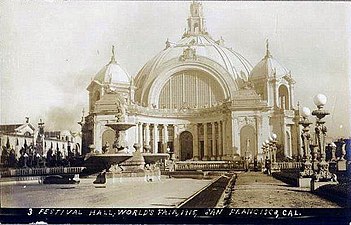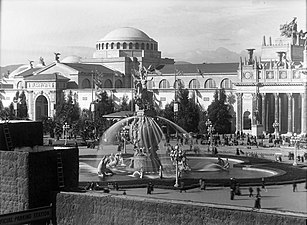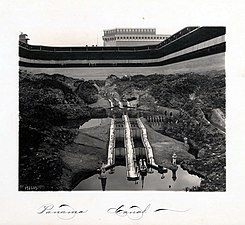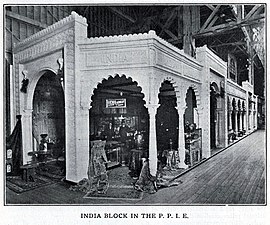Panama–Pacific International Exposition
| 1915San Francisco | |
|---|---|
 Poster for the exhibition | |
| Overview | |
| BIE-class | Universal exposition |
| Category | Historical Expo |
| Name | Panama-Pacific International Exposition |
| Area | 636 acres (257 ha) |
| Visitors | 18,876,438 |
| Organized by | Charles C. Moore |
| Participant(s) | |
| Countries | 24 |
| Location | |
| Country | United States |
| City | San Francisco |
| Venue | Marina District |
| Coordinates | 37°48′16.8″N122°26′48″W/ 37.804667°N 122.44667°W |
| Timeline | |
| Opening | February 20, 1915 |
| Closure | December 4, 1915 |
| Universal expositions | |
| Previous | Exposition universelle et internationale (1913)inGhent |
| Next | Independence Centenary International ExpositioninRio de Janeiro |
| Simultaneous | |
| Other | Panama–California Exposition |
ThePanama–Pacific International Expositionwas aworld's fairheld inSan Francisco,California, United States, from February 20 to December 4, 1915. Its stated purpose was to celebrate the completion of thePanama Canal,but it was widely seen in the city as an opportunity to showcase its recovery from the1906 earthquake.The fair was constructed on a 636-acre (257-hectare) site along the northern shore, between thePresidioandFort Mason,now known as theMarina District.
Exhibits and themes[edit]

Among the exhibits at the exposition was theC. P. Huntington,the firststeam locomotivepurchased bySouthern Pacific Railroad;the locomotive is now on static display at theCalifornia State Railroad MuseuminSacramento.[1]Atelephoneline was also established toNew York Cityso people across the continent could hear thePacific Ocean.TheLiberty Belltraveled by train on a nationwide tour fromPhiladelphia, Pennsylvania,to attend the exposition.[2]
The1915 American Grand PrizeandVanderbilt Cupauto races were held February 27 and March 6 on a 3.84-mile (6.18 km) circuit set up around the Exposition grounds.[3]TheSmithsonian Institutionalso had an exhibition at the Exposition.[4]
Indigenous representation[edit]
Native American culture was a topic of interest during the nine-month long exposition with multiple attractions dedicated to Native American life. The most popular attraction at the exposition that depicted Native American life is James Earle Fraser's statueThe End of the Trail.[5]Fraser's statue, which showed a Native American man slumped over on a horse, reflected the American idea at the time, that the Native American race was doomed for extinction. The exposition not only celebrated the completion of the Panama Canal, but also advances made by the American people, part of which were the conquests of indigenous people by Americans as well as Europeans.[6]These celebrations over the Native community, can be seen through artworks such asThe End of the TrailandThe Pioneeror tributes to Francisco Pizarro and Hernán Cortés.[5]In comparison to previous world fairs, the Panama–Pacific International Exposition showcased Native Americans more as nobles rather than savage people, but who were still inevitably destined to become extinct. These ideas were presented in plays, known as pageants, where Native Americans played small roles such as in "Catalonian dragoons, muleteers, and a tribe of Carmel Indians."[6]While the demise of Native American people was a rhetoric created by fair organizers, scholars have argued that in reality, the Native persona was very present and did not reflect the idea that it was a disappearing civilization. Native Americans were in fact part of the fair, but also attended as visitors, performers, and workers.[6]More recently, scholars have focused on Native representation in San Francisco's 1915 rival world fair, San Diego's 1915 Panama–California Exposition, that showed Native American life in a more anthropological light versus this American ideal.[7]
Women and gender roles[edit]
During the Panama–Pacific International Exposition women were in charge of their own board, known as the Woman's Board of San Francisco's Panama–Pacific International Exposition.[8]The board, also called the Board of Lady Managers, allowed women to take part in organizing different aspects of the fair and more importantly gave them the opportunity to have a campaigning platform for discussing women's rights and social issues. It was commonly argued that the fair celebrated male dominance over women by not providing a building for women.[8]Also, men and women were depicted differently in artworks advertising the exposition. White women, specifically, were presented as caretakers while men as strong and powerful saviors, such as in the poster “13th Labor of Hercules.”[8]

At the time, there was an idea of a “New Woman” who was more progressive and advanced intellectually and sexually.[8]This idea of a “New Woman” related to the overarching themes of the fair: modernity, and progress. In efforts to promote the fair, organizers used the “New Woman” as an advertising tactic and proof that San Francisco was an evolving and safe environment for tourists.[8]During the fair, women could be seen posing with agriculture from around the state in celebration of California's produce. All the women were young, beautiful white women who were often the highlight of newspaper articles and events. This use of women presented the idea that they were useful only for their beauty but failed to appreciate their intellectual capacity and physical abilities.[8]
TheInternational Conference of Women Workers to Promote Permanent Peacewas held on July 4–7 in the "Peace Palace", a transformation of the Civic Auditorium (now theBill Graham Civic Auditorium).May Wright Sewall,by appointment ofCharles C. Moore,chair of the exposition, organized the peace conference. It was attended by women pacificists from all over the world, especially the neutral countries ofWorld War I.[9]
One of the most memorable achievements of the Women's Board was the installation of statues that celebrated women, specifically mothers, known as thePioneer Mother.[10][11][12][13]: 148, 151 [14]
TheNational Society Colonial Dames XVII Centurywas established by six women while attending the exposition.[15]
Architecture[edit]

AFine Arts
BEducation
CSocial Economy
DLiberal Arts
EManufacturers
E1Varied Industries
FMachinery
GTransportation
HAgriculture
IAgriculture (Food Products)
JLive Stock
KHorticulture
LMines and Metallurgy
The centerpiece was theTower of Jewels,which rose to 435 feet (133 m) and was covered with over 100,000 cut glass Novagems. The3⁄4-to-2-inch (19 to 51 mm) colored "gems" sparkled in sunlight throughout the day and were illuminated by over 50 powerful electrical searchlights at night.
South of the Tower, the Fountain of Energy flowed at the center of the South Gardens, flanked by the Palace of Horticulture on the west and the Festival Hall to the east. The arch of the Tower served as the gateway to the Court of the Universe, leading to the Court of the Four Seasons to the west and the Court of Abundance to the east. These courts formed the primary exhibit area for the fair, which included the Palaces of Food Products, Agriculture, Liberal Arts, and Education and Social Economy and surrounding the Court of the Four Seasons; and the Palaces of Transportation, Mines and Metallurgy, Varied Industries, and Manufacturers surrounding the Court of Abundance.
The central court group was bookended on the east by the Palace of Machinery, the largest of all the halls built for the Exhibition, and on the west by thePalace of Fine Arts,which survives onsite.
Further west into the Presidio, down The Avenue of the Nations, were national and states' buildings, displaying customs and products unique to the area represented. The far western end of the Fair, past the states' pavilions, was reserved for live stock exhibits. At the opposite end of the Fair, nearFort Masonwas "The Zone", an avenue of popular amusements and concessions stands.
Construction[edit]
Constructed from temporary materials (primarilystaff,a combination of plaster and burlap fiber), almost all the fair's various buildings and attractions were pulled down in late 1915. Intended to fall into pieces at the close of the fair (reportedly because the architect believed every great city needed ruins), the only presently-surviving building on the Exposition grounds,Bernard Maybeck's Palace of Fine Arts, remained in place, slowly falling into disrepair.[16]The hall, used to display painting and sculpture during the Fair, was repurposed as a garage for jeeps duringWorld War II.[1]The Palace, including the colonnade with its signature weeping women and rotunda dome, was completely reconstructed in the 1960s and a seismic retrofit was completed in early 2009. TheExploratorium,an interactive science museum, occupied the northern 2/3 of the Palace from 1969 to 2013; the city-owned Palace of Fine Arts Theater, has occupied the southern 1/3 since 1970.
Several other buildings were saved immediately following the Exposition, including the California, Missouri, and Philippine buildings, which were built on government land.[17]
Other surviving buildings[edit]
Buildings from the Exposition that still stand today (other than the Palace of Fine Arts) include what is now called theBill Graham Civic Auditoriumat Civic Center Plaza and the Japanese Tea house, which was barged down the Bay toBelmont, California,and operated successively as a private residence, speakeasy, and restaurant.[18]
Also surviving are the one-third scale steam locomotives of the Overfair Railroad that operated at the Exposition. They had been maintained in working order at theSwanton Pacific Railroad Societylocated on Cal Poly San Luis Obispo'sSwanton Ranchjust north of Santa Cruz. But a forest fire swept through the area in 2020, severely damaging the railroad, which has not run since then.[19][20]
TheLegion of Honor Museum,inLincoln Park,was the gift ofAlma de Bretteville Spreckels,wife of the sugar magnate andthoroughbredracehorseowner/breederAdolph B. Spreckels.[21]The building is a full-scale replica of the French Pavilion from the 1915 Panama–Pacific International Exposition, which in turn was a three-quarter-scale version of thePalais de la Légion d'Honneuralso known as the Hôtel de Salm inParisbyGeorge Applegarthand H. Guillaume. At the close of the exposition, the French government granted Spreckels permission to construct a permanent replica of the French Pavilion, but World War I delayed the groundbreaking until 1921.[22]
The warehouse for the exposition was moved toFort Hunter Liggettin South Monterey County and the structure, nicknamed the "Tin Barn", has served as the base fire department for the last 30 years. After its move, it initially served as a horse barn, and since then, it has served as a gym, PX and a movie theater for the base.[23][24]
Commemorations and legacy[edit]
 |
 |
TheUS Post Officeissued a set of fourpostage stampsto commemorate the exposition, with designs depicting a profile ofVasco Núñez de Balboa(1¢), thePedro Miguel Locksof thePanama Canal(2¢), theGolden Gate(5¢), and the discovery ofSan Francisco Bay(10¢). The stamps were first put on sale in 1913, to promote the coming event, and perforated 12, and then reissued in 1914 and 1915, perforated 10. Their prices today range widely; the 2¢ of 1913 is available for under a dollar in used condition, while an unused 10¢ of the scarcer orange-yellow variety in 1915 can be worth up to a thousandUnited States dollars.[25][26]
TheUnited States Congressauthorized theSan Francisco Mint(also known as "The Granite Lady" ) to issue aseries of five commemorative coins.Said coins were the 1915-S silver Panama-Pacific half dollar and four gold coins. The denominations of the gold coins were $1, $2+1⁄2(quarter eagle) and $50 (in two types: a round coin, and an unusual octagonal coin). The Panama-Pacific coins have the distinction of being the first commemorative coins to bear the motto "In God We Trust", and were also the first commemoratives to be struck at a branch mint.[27]The two lower denomination gold coins are scarce, while the two $50 ones are extremely rare. The silver half dollar had a mintage of 27,134 and in modestly worn condition is available for several hundred dollars.[citation needed]
 |
 |
NumismatistFarran Zerbesupervised the creation of a series of commemorative medals, an award medal, a souvenir medal, and diplomas.[28]
Centennial[edit]
In 2015, theCalifornia Historical Society,the Maybeck Foundation, and Innovation Hangar partnered with the City and County of San Francisco to commemorate the centennial of the transformative 1915 Panama Pacific International Exposition.[29]
On June 20, 2015 a commemorative orchestra, chorus and band concert was held at the Palace of Fine Arts to celebrate the 100th anniversary of the fair.
A feature film,When the World Came to San Francisco,which tells the story of the fair, was made by writer and director R. Christian Anderson. It was part of the city's official centennial celebration sanctioned by the California Historical Society. The film had its world premiere at thede Young Fine Arts Museumin Golden Gate Park on October 30, 2015.[30]
Gallery[edit]
-
Aerial view of the Panama–Pacific International Exposition, directed southeast. The exposition buildings have been colored to distinguish them; the area, then known as Harbor View, is now theMarina District.
-
Modern view of PPIE grounds, directed east-southeast in 1980; cropped from a photograph byCarol Highsmith.ThePalace of Fine Artsis prominent in the foreground.
-
View north-northeast; the Tower of Jewels is prominent in the center, and the domed Palace of Horticulture can be seen on the left.Alcatraz Islandcan be seen in the background.
-
General view of the South Gardens directed west, with the Palace of Horticulture (left) and Tower of Jewels (right)
-
Festival Hall
-
Tower of Jewelsat night
-
Palace of Horticulture
-
San Francisco,Autochrome Lumière(1915)
-
Fountain of Energy
-
California Building
-
The model of thePanama Canal
-
Palace of Fine Arts,by Exposition exhibitorColin Campbell Cooper
-
The State of Wisconsin Pavilion
-
The "India Block" at the Exposition.
-
Floodlit pavilion at the Panama–Pacific International Exposition. The Tower of Jewels on the left, and the Italian Tower on the right
-
The Court of Palms, with the Palace of Horticulture at background
-
Modern picture of thePalace of Fine Arts,the only building surviving today (reconstructed) still on the exposition grounds
See also[edit]
- The Tower of Jewels
- The Pioneer,a sculpture bySolon Borglumthat debuted at the exposition
- Mabel and Fatty Viewing the World's Fair at San Francisco
- "Lines on "The Muse Finding the Head of Orpheus"by John E. D. Trask
- Golden Gate International Exposition(1939–40 SF World's Fair)
- List of world expositions
- List of world's fairs
References[edit]
- ^abBragman, Bob (December 15, 2015)."Panama–Pacific International Exposition 1915 – family photo memories".San Francisco Chronicle.Retrieved27 August2020.
- ^"Liberty Bell Attracts Crowd in Greenville During 1915 Stop". Greenville Advocate. July 3, 2007.
- ^Nye, Doug(1978).The United States Grand Prix and Grand Prize Races, 1908–1977.Garden City, NY:Doubleday.pp. 32–33.ISBN978-0-385-14203-8.
- ^"Brochure for the Panama–Pacific International Exposition".Smithsonian Institution Archives.Retrieved25 May2012.
- ^abMarkwyn, Abigail (April 2016). "Beyond The End of the Trail: Indians at San Francisco's 1915 World's Fair".Ethnohistory.63(2): 273–300.doi:10.1215/00141801-3455299.
- ^abcMunro, Lisa (2010). "Investigating World's Fairs: an Historiography".Studies in Latin American Popular Culture.28(1): 80–94.doi:10.1353/sla.0.0001.S2CID142791404.Project MUSE388610.
- ^Krasniewicz, Louise (Spring 2015)."All the World in One Place".Expedition.57(1). Penn Museum: 7–13.
- ^abcdefMarkwyn, Abigail M. (February 2016). "Queen of the Joy Zone Meets Hercules: Gendering Imperial California at the Panama–Pacific International Exposition".Western Historical Quarterly.47(1): 51–72.doi:10.1093/whq/whv039.
- ^Davidson, Marie Hicks (May 1915)."To Promote Permanent Peace".Table Talk.30(5). Arthur H. Crist Company: 270–275.OCLC1715377.
 This article incorporates text from this source, which is in thepublic domain.
This article incorporates text from this source, which is in thepublic domain.
- ^"Sculptor Grafly Chosen Will Model Fine Statue".San Francisco Call.August 18, 1913.Retrieved27 August2020.
- ^“The Pioneer Mother’s Monument – What it Should Be,”San Francisco Call and Post,26 June 1914
- ^Frink, Brenda D. (2012). "San Francisco's Pioneer Mother Monument: Maternalism, Racial Order, and the Politics of Memorialization, 1907–1915".American Quarterly.64(1): 85–113.doi:10.1353/aq.2012.0001.PMID22826896.S2CID46422099.
- ^Simpson, Anna Pratt (1915). "IX. Motherhood Monument".Problems Women Solved: Being the Story of the Woman's Board of the Panama–Pacific International Exposition; What vision, enthusiasm, work and co-operation accomplished.San Francisco: The Woman's Board. pp. 146–164.
- ^“Motherhood Monument to be dedicated to Pioneer Mothers,” folder 11, box 52, San Francisco Misc/Ephemera Oversize Pamphlets Relating to the Panama–Pacific International Exposition, Panama–Pacific International Exposition Company Papers, California Historical Society, San Francisco.
- ^"Background to the Society".The National Society Colonial Dames XVII Century.The National Society Colonial Dames XVII Century.RetrievedAugust 27,2023.
- ^McCoy, Esther(1960).Five California Architects.New York: Reinhold Publishing Corporation. p. 6.ASINB000I3Z52W.
- ^Redman, Jeanne (November 8, 1915)."Fair Buildings Will Be Saved".Stockton Independent.Los Angeles Times.Retrieved27 August2020.
- ^"History".The Van's.Retrieved27 August2020.
- ^"Swanton Pacific Railroad – Davenport, CA".Swanton Pacific Railroad.
- ^"Swanton Pacific Railroad".www.facebook.com.
- ^"About ArtPoint".Archived fromthe originalon 2008-06-25.Retrieved2008-12-12.
- ^"History of the Legion of Honor".Legion of Honor.June 28, 2011.
- ^"Fort Hunter Liggett".Historic California Posts, Camps, Stations and Airfields.Retrieved27 August2020.
- ^"Did you know: The Fire Station is a 1915 Tin Barn?"(PDF).The Golden Guidon.U.S. Army Garrison Fort Hunter Liggett. September 2016.Retrieved27 August2020.
- ^"Panama-Pacific Exposition Issue".Smithsonian national postal Museum.RetrievedNovember 25,2023.
- ^Scott Specialized Catalogue of United States Stamps, p. 68
- ^"1915 Panama Pacific Exposition Coinage".www.pdxcoinclub.org.Archived fromthe originalon 2015-09-24.Retrieved2007-08-17.
- ^"Panama-Pacific Expo 5 Coin Set on exhibit at Santa Clara Expo: Coin Collecting News".www.coinlink.com.Retrieved2017-06-05.
- ^"Home – Panama–Pacific International Exposition".Panama-Pacific International Exposition.
- ^When the World Came to San Francisco,ppie100.org
Further reading[edit]
- Laura A. Ackley, "San Francisco's Jewel City: The Panama-Pacific International Exposition of 1915." Berkeley, CA: Heyday, 2014.
- Lee Bruno, "Panorama: Tales from San Francisco's 1915 Pan-Pacific International Exposition." Petaluma, CA: Cameron+Company, 2014.
- Abigail M. Markwyn, "Empress San Francisco: The Pacific Rim, the Great West, and California at the Panama-Pacific International Exposition." Lincoln, NE: University of Nebraska Press, 2014.
- Sarah J. Moore,Empire on Display: San Francisco's Panama-Pacific International Exposition of 1915.Norman, OK: University of Oklahoma Press, 2013.
External links[edit]
- Official website of the BIE
- Historical photography of the Panama Pacific International Exposition
- JB Monaco Panama Pacific International Exposition Photo Gallery
- The Panama-Pacific International Exposition at San Francisco, 1915(1915). FromInternet Archive.
- Panama-Pacific International Exposition, San Francisco, 1915 (1914)FromInternet Archive
- Catalogue de luxe of the Department of Fine Arts, Panama-Pacific International ExpositionFromInternet Archive
- Panama-Pacific International Exposition AND mediatype:moviesFromInternet Archive.
- The Panama Pacific International Exposition,fromSan Francisco Memories
- Panama-Pacific International Exposition Map – 1915,from theVirtual Museum of the City of San Francisco
- Virtual Tour of the Panama Pacific International Expositionfrom the History Center at theSan Francisco Public Library
- Panama-Pacific International Exposition photographic collections,via Calisphere
- California Digital LibraryGuide to the Panama Pacific International Exposition RecordsatThe Bancroft Library
- Books about the ExpositionatProject Gutenberg


















